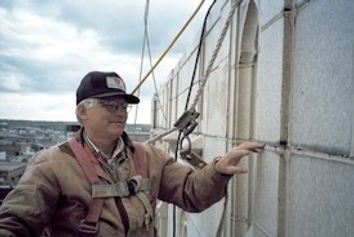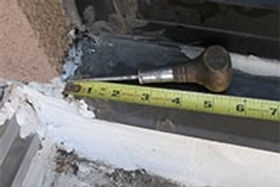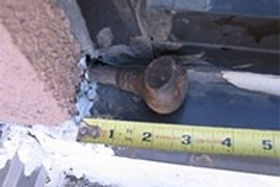Expert Solutions to problems in roofing and exterior building envelope performance for over 20 years. Call Now for a free consultation: 574.234.2198

Building Envelope Services

Traditional or historical wall assemblies such as solid masonry, terra cotta, and limestone require periodic maintenance and occasional restorations. Inappropriate or inferior restorations sometimes do more harm than good. Examples of damage caused by poor restorations:
-
Caulking structural steel lintel joints which traps moisture in the wall and leads to rust scale that jacks-up exterior masonry which results in stair-stepped cracks and more water infiltration.
-
Caulking weep holes shut resulting in water trapped in the wall.
-
Repointing with mortar that is too hard which results in spalling brick or stone.
-
Sealing in moisture with non-breathable moisture repellants or impermeable paint.
-
Terminating roof to /wall base flashing above thru-wall flashing or weep hole height.
Terra Cotta joint inspection
Modern day composite wall, rain screen wall, or cavity wall assemblies often develop moisture accumulations at various layers between the inside and outside surfaces. The cause can sometimes be complex and when it is, owners may need professional moisture migration investigation to determine the source and the best solution.
Typical moisture migration causes:
-
Vapor drive from warm areas to colder areas.
-
Condensation on vapor retarders below dew point temperatures.
-
Lack of air barriers allowing warm moist air to migrate and condense on cooler surfaces.
-
Leaks at improper or deteriorated flashing.
-
Pressure induced rain infiltration.
-
Moisture absorption.
-
Improper venting.
Flashings around the roof, walls, windows, skylights, mechanical equipment, vents, etc. are notorious sources of leaks and water infiltration. Often the original cause was lack of, or, faulty design, but usually the cause is also due to poor installation during construction or lack of maintenance.
Some curtain wall, thin stone veneers, metal panel, Exterior Insulated Finish System (EFIS), tilt-up concrete, and single-wythe block systems all have unique challenges with moisture infiltration. Expansion and contraction movement of dissimilar materials must be planned during design and verified workable during installation. Concrete block back-up walls shrink over time and clay (brick) products expand as they age. Dissimilar metals expand at different rates and some metals are not compatible together. Control joint must be placed at calculated intervals to accommodate this movement and work in harmony with adjacent materials. When errors in initial design or construction do not take these material characteristics into consideration resulting in cracks or other deterioration that allows moisture infiltration, ConSpecT diagnoses the source of the problem then designs and specifies solutions.
In 2006, RCI, Inc. (formerly Roof Consultants Institute) expanded its mission to include exterior walls because RCI members have been increasingly called upon to address building-wide concerns. This action reflects the understanding that roofing issues often influence the entire building envelope and problems in walls at or above roof level often influence roof performance. Even prior to 2006 most of RCI’s educational programs, symposiums, and the professional journal “Interface” contained technical sessions and technical articles on wall system design and problem solving. We now have a network of professional wall & waterproofing experts to associate with and brainstorm solutions.
Below grade waterproofing and plaza deck waterproofing are expensive areas to incur moisture infiltration. Most of the cost is in removing overburden to get to and repair problem areas. Though waterproofing has traditionally been part of the roofing industry (because prior to mid 1900s nearly all W/P membranes were bitumen based), waterproofing now takes special expertise in both design and installation. There is a dangerous trend developing to put green roofs and plaza decks on standard single-ply roof membranes. Careful consideration to below surface drainage, hydraulic pressure, and protrusion flashing needs to be part of the design and verified during installation. A ConSpecT staff member was certified as a Green Roof Professional (GRP) as certified by the organization Green Roofs for Healthy Cities in 2009.
ConSpecT's founders have a combined experience of president has over 70 years in construction inspection, leak investigations, moisture migration problem solving, and waterproofing solutions. Our forensic investigations not only solve problems for our clients, the findings are also a valuable tool for us to avoid errors in design and construction quality monitoring administration. What can we do to help you solve your building envelope problems?
If you are experiencing deterioration within your building envelope, call or contact ConSpecT for professional solutions to problems in exterior walls and roofs.

Vapor drive deterioration

2½" probe at window jamb
